Ag Chris Grinter, ar 24 Feabhra, 2010
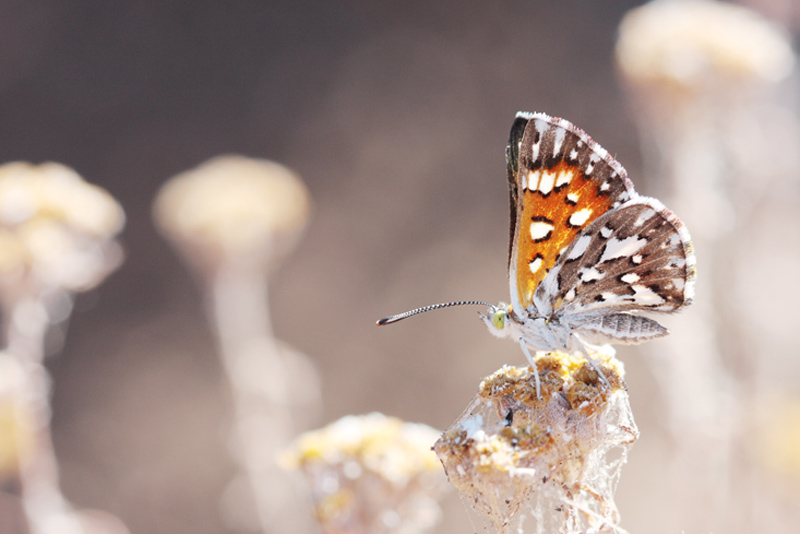
Know seo féileacán? Tá sé ceart go leor, dhéanann aon duine i ndáiríre. Tá sé i ghéineas Apodemia (Riodinidae), ach tá an tacsanomaíocht an ghrúpa tubaiste… Ní gá agus fiú tús a chur orm ar an fospeiceas. Bhí grianghraf an t-eiseamal i mí Mheán Fómhair, chiallaíonn go bhfuil sé an chuid is mó dócha go mbeidh Apodemia mormo (Mormon) based on flight time. A. Mormon is a fall flyer and A. virgulti is a spring flyer. While some forms seem distinctive, there is massive morphological overlap and they are usually identical and sympatric – actually down to living on the same plants. But according to lab experiments it is impossible to get the pupae to break diapause so they remain reproductively isolated. So are they different? While molecular work is being conducted the verdict is out, but it does seem like these two species may be retained in the end. Agus ar ndóigh, each mountain range has it’s own subspecies. Who knows, I sure don’t. I’m glad I don’t work on butterflies.
Species concepts are a fuzzy line and it’s never clear exactly where to make the cut. When asked what a species is most people default to the Mayr concept of Biological Species (BSC), where reproductive isolation = new. This is all well and good but we have to keep in mind that this is not the ONLY species concept. Tá dozens, and not one is perfect. Groups like Grammia (Noctuidae: Arctiinae) exhibit high levels of hybridization, which does not adhere well to the BSC. I like to apply as many criteria as possible to delimit a species and it seems like the line is all too commonly thin within insects. I like to see a distinguishing morphological trait, if not in wing color or pattern, at the least in the genitalia or antennae. This is not always the case however and you have to look at the biology and/or DNA. I have looked at two insects that are for all intents and purposes identical. But the biology is radically different and a large % difference (over 8% – yes, arbitrary) in their DNA makes it unquestionable that they are separate.
And if species weren’t contentious enough subspecies stir the pot even more. I’m skeptical about the entire concept, but there are cases in which it seems plausible and necessary. A subspecies is a more formal definition of a geographical “foirm” and usually exhibits a blend zone into another subspecies. For instance if you look at the 27 different populations of Plebejus icarioides there are large differences between northern and southern populations, but very subtile difference along the gradient. It is that persistent gradient that creates one dynamic species instead of 27 separate species – at least according to current research. Moths have been lucky and have thus far avoided the plague of over-subspeciation, butterflies not so much. There may even be instances where greedy collectors have named new subspecies of Parnassius for profit (new rare butterfly subspecies sell for big bucks).
The truth is that species concepts are artificial, poorly understood and dynamic at best; at worst it approaches a soft science with no real possibility of proof. Yet species are real and theories will continue to adapt while we sit here and scratch our heads.
Ag Chris Grinter, 23 Feabhra, 2010 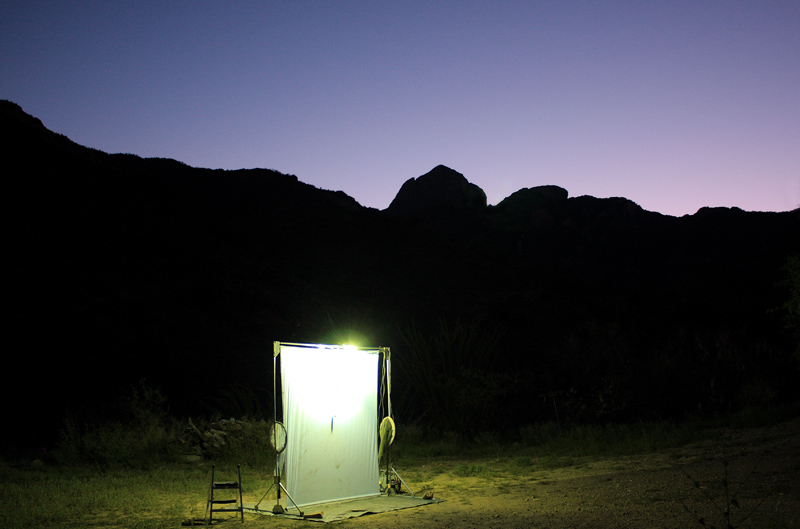
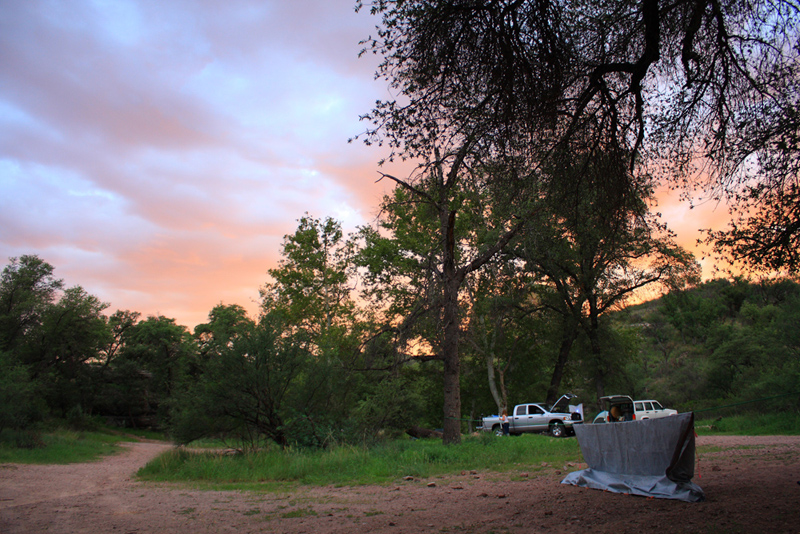
Ceann de na perks a bheith ina feithideolaí atá ag taisteal agus a bhailiú. Chuir mé cúpla míle míle ar an gcarr gach samhradh agus tá siad seo dhá cheann de na háiteanna is fearr i Arizona a bhailiú. Is é an íomhá barr ó na Sléibhte Baboquivari (Baboquivari Buaic i lár), Stáisiún Taighde Canyon Brown. The bottom image is of Pena Blanca Canyon, a famous collecting hotspot. This canyon is just 5 miles from Mexico and has a few safety concerns because of our current immigration policy. One morning, while sorting moths from the previous nights catch, a colleague and I had a group of roughly 30 illegals walk right through our camp. They were well dressed and clean, waved, and must have just been dropped off at the fence. Thankfully the majority of illegals are hard-working and honest people trying to earn a better life. It’s the coyotes and smugglers that are scarier – I have heard tales of Mexican police escorting drug caravans into the US with heavy artillery. And just last year a border patrol agent was stabbed to death by a coyote in this vicinity.
Go raibh maith agat, a bunch of strange guys standing around strange lights at nights grants us a wide berth.
(Are these images small enough to load quickly?)
Ag Chris Grinter, 23 Feabhra, 2010 In ainneoin a bheith go leor disinterested i féileacáin, Tá siad deas chun breathnú ar. Seo físeán gur mór ag Guy a fhios agam síos i nDeisceart CA. Tá a chuid ama caite físeáin de saolréanna Lepidoptera suntasach go leor, agus tá sé seo ar cheann go háirithe álainn. Má gearrtha tú go dtí thart ar 3:00 i, you will see dozens of Great Purple Hairstreaks (Atlides halesus) emerging from their chrysalises, the colors are stunning. This butterfly is native to the SW and Mexico, and I have to admit I love finding it in the field.
[youtube = http://www.youtube.com/watch?v=KyWJlpIchkE]
Ag Chris Grinter, 23 Feabhra, 2010 The brief comment about Linus Pauling and Vitamin C below made me remember this video first posted a while ago by Pharyngula. Is é seo an Kary Mullis, ar na bacáin PCR, agus buaiteoir Duais Nobel. A aireagán a rinneadh go bunúsach anailís DNA agus is féidir. Ach cosúil le Pauling, Tá sé freisin go hiomlán agus go hiomlán cnónna. If you have the time to listen to him ramble, give it a shot. Ach i mbeagán focal, he discusses astrology, denies global warming and how AIDS is not caused by HIV. I wonder what the stats are for genius scientists that slide off their rocker?
[Vimeo 9167379]
Ag Chris Grinter, 22 Feabhra, 2010 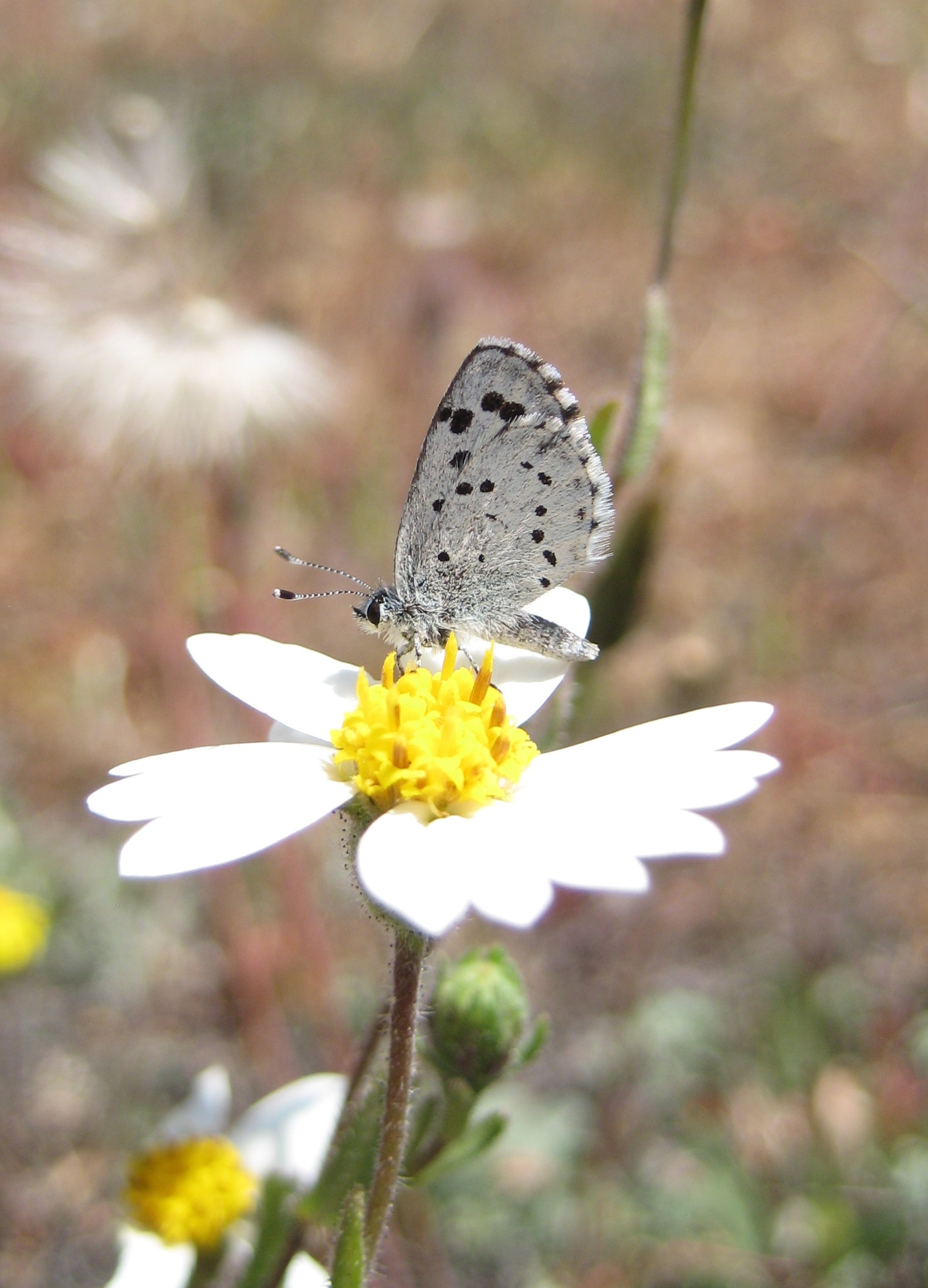
Is é seo an íomhá sean de mo, mar sin nach bhfuil sé foirfe. Más féidir leat insint dom an féileacán do speicis tú ard-cúig. Má tá a fhios agat an fospeiceas, Feicfidh mé sheolann tú pacáiste nua de #3 bioráin cruach dhosmálta! Ach leid: Tá sé ó na Stáit Aontaithe Mheiriceá iarthair.
Ag Chris Grinter, 22 Feabhra, 2010 Sa lá atá inniu fuair mé seo alt i NY times health – touting na buntáistí a bhaineann acupuncture a úsáidtear le haghaidh faoisimh dúlagar i mná torracha. Tá mé cúpla fadhbanna leis an iriseoir, Shirley S. Wang, mainneachtain a bheith skeptical ina phíosa. Ach tagann sé seo mar aon iontas, mar sin ní bhacfaidh mé lochtanna soiléire sna meáin a chur in iúl.
Cuirfidh mé na lochtanna sa staidéar in iúl. Faigh an buntéacs iomlán le do thoil, anseo. Mar sin tar éis dom an páipéar seo a léamh tháinig mé ar roinnt conclúidí.
1) Méid sampla an-bheag de 150 othair, amháin 141 cóireáilte.
2) Tá an staidéar dalláilte AMHÁIN don scóráil dúlagar, ní riarachán acupuncture. Go deimhin, stáit a bhfoirm scaoileadh “Gheobhaidh rannpháirtithe i gceann den dá ghrúpa seo acupuncture a dhíríonn ar na hairíonna dúlagar agus ní bhfaighidh an chóireáil eile.” Déanann ciall, tá sé éasca a thabhairt faoi deara go bhfuil snáthaid shoved i do chraiceann. Mar sin,, iad seo “randamach agus dalláilte” bhí a fhios ag na rannpháirtithe cad a bhí le teacht agus ghlac siad leis go raibh aon phógadh ceaptha chun cabhrú lena ndúlagar. ina theannta sin, seo (i bhfad níos fearr) staidéar Tá sé léirithe go n-oibríonn acupuncture insamhladh le toothpicks díreach mar an gcéanna. Cúramach, is fianaise an-láidir é seo i gcoinne bhailíocht acupuncture – ní fianaise ar úsáideacht spreagtha “pointí brú”. Is éifeacht phlaicéabó é.
3) Glacann an staidéar le bailíocht “dúlagar sonrach” agus “neamh-sonrach” acupuncture. Ciallaíonn modh amháin greamaithe bioráin ar bhealach éigin leigheasanna dúlagar thar mhodh eile. Ar a bhfuil sé seo bunaithe? Ó fan, deir siad go díreach an fhianaise eolaíoch uileghabhálach ar dheis anseo: “patrúin easaontais de réir phrionsabail leigheas traidisiúnta na Síne”. Tá brón orm, le do thoil, tabhair dom leigheas nua-aimseartha thall 2,000 creidimh miotasacha bliain d'aois. Conas a bhí an meánchaighdeán saoil agus ionchas saoil do dhuine Síneach ársa? Pretty diabhal Uafásach, agus táim cinnte nár sháraigh an meán-ionchas saoil 35 blianta.
4) Scóir dúlagar a bhunú ar riarachán amháin de Scála Rátála Hamilton DSM-IV. Gan a bheith i mo shíciatraí ní féidir liom labhairt faoi éifeachtúlacht na dtrialacha seo. Ach, Rachaidh mé amach ar ghéag agus glacfaidh mé leis gur cheart bunlíne níos láidre a bhunú don dúlagar sula ndéantar comparáid idir na torthaí. Féadfaidh an tástáil a bheith cruinn, ach cén fáth nach é a riar níos mó ná uair amháin chun torann a laghdú.
5) Roghnú massage mar an dara rialú. Is droch-iarracht é seo ar amhras chomharthaí, luann siad fiú ceart as an bat “Bhí conceptualized massage mar chóireáil rialaithe mar gheall ar, cé go bhfeabhsaíonn sé giúmar díreach tar éis seisiún, níl dóthain fianaise ann chun tacú lena éifeachtúlacht mar chóireáil don dúlagar.” Agus staidéar á dhearadh agam is maith liom féachaint ar na tosca aitheanta go léir a chreidim a bhréagnóidh mo hipitéis. Ní léiríonn roghnú rud éigin a chreideann tú cheana go dteipfidh air ach a lámh laofachta comhlán.
6) Teip rialaithe le haghaidh fachtóirí socheacnamaíocha. 67% de na rannpháirtithe a bhí bán, agus bhí an chuid is mó acu oilte go maith. Téann siad fiú chomh fada agus a lua sa phlé “Dá bhrí sin, d'fhéadfadh sé nach ndéanfaí ginearálú ar thorthaí do ghrúpaí mionlaigh ar leith a bhí tearc-ionadaithe inár sampla”. An bhfuil sé ach mise, nó an ndiúltaíonn an ráiteas seo a gcuid taighde ina iomláine? Admhaíonn siad go saor go mb’fhéidir nach n-oibreodh acupuncture chomh maith i ngrúpaí mionlaigh eile. Cén fáth go bhféadfadh sé seo a bheith? Is é an t-aon fhreagra loighciúil agus eolaíoch amháin ná go bhfuil difríocht idir éifeacht phlaicéabó trasna teorainneacha socheacnamaíocha. Dá, tar éis gach rud, Ba eolaíocht dhlisteanach leighis é acupuncture, bheadh difríocht neamhshuntasach le feiceáil trasna orgánaigh atá comhionann go fiseolaíoch.
Is droch-eolaíocht an staidéar seo. Tá na taighdeoirí seo ag tosú leis an mbonn go n-oibríonn acupuncture, agus cuardach le haghaidh sonraí chun tacú lena n-éilimh. Tá sé seo go díreach contrártha le conas a sheoladh eolaíocht fíor. Agus, ní raibh ár dtuairisceoir sláinte ag an NY Times iata fiú. Teip ort Mrs. Wang, agus teipeann ar an NY Times.
Ag Chris Grinter, ar an 21 Feabhra, 2010 Is breá liom Ming Tsai agus a impireacht cócaireachta oiread agus is an chéad cheann eile breathnóir teilifíse 3-rn. I ndáiríre, his recipes are fantastic and you should make them yourself. Ach tá mé faoi deara go raibh claonadh corr dó a rá (aralleadh) “ba chóir duit a úsáid i gcónaí orgánach, tá sé i bhfad níos fearr ar do shon”. Fágann sé seo dom le beagán puzzled. What exactly does he mean? Ming is well-educated and this is not anything he should be solely responsible for, but he echoes an all too common misconception that organic is actually better. By better I am interpreting this as healthier, which seems to be a logical gap to bridge. Mar sin,, let’s look at the data.
A recent and comprehensive review published in the American Journal of Clinical Nutrition has largely convinced me of what I was always skeptical of; that organic foods can not actually be healthier for you. In their breakdown they cited 55 studies and came to the conclusion that “there is no evidence of a difference in nutrient quality between organically and conventionally produced foodstuffs”.
So what is the harm? My problem with all of this is that it is based on the naturalistic fallacy, go “natural” nó “organic” somehow means that the product is safer or healthier. How many times do you see the term “natural” in the store and never give it second thought? If natural things really were safer then traditional Ayurvedic medicines would not be horribly toxic. Afterall, arsenic, lead and mercury are NATURAL – but they are also some of the most toxic compounds known to man. In the end it is 100% marketing.
Taken from another angle Ming Tsai may not be all that incorrect afterall. I do not have all the data in front of me regarding pesticide contamination of foodstuffs, but it is logical to assume the less contaminated the better. Obviously pesticides can be a bad thing, there are mountains of literature to support the damage they can cause. But the jury seems out on exactly how bad, más rud é ar chor ar bith, these minute residues on our foods are. Conventionally grown foods have regulated levels of residues, but even organics are not free of pesticide contamination. So I look at it differently. Our environment benefits from having safer food. Less chemicals are dumped into our waterways, farmers have to battle less with incredibly powerful toxins, agus blinky the fish fights to see another day. We should all strive to live sustainably and organic farming does provide us with an edge.
So once again, what is the harm? People who buy organic quite possibly do so based on genuine environmental stewardship. I would also argue that a very high percentage of these people also believe these foods are healthier (anyone have survey data to support this claim?). So in this instance the result is a net positive. Ach, being right for the wrong reasons should never be acceptable. This strikes at the peak of a larger problem that is driven by marketing and zero science. Case in point – Vitamin C as a cold remedy. A study in PLOS medicine has shown there is no indication for efficacy of VitC against the common cold. Téigh figiúr, a once believed to be true staple has begun to be picked apart by science and data. Let’s be careful on what bandwagon we jump and why.
Ag Chris Grinter, ar an 21 Feabhra, 2010 [youtube = http://www.youtube.com/watch?v=zSgiXGELjbc]
Mé taitneamh a bhaint as i ndáiríre an Sagan autotuned, a dhéanann mé leis go raibh mé an eloquent. Watch more videos here at the Symphony of Science.
Ag Chris Grinter, ar an 21 Feabhra, 2010 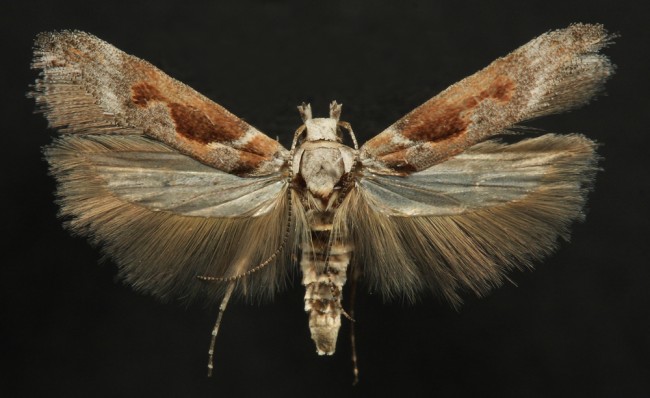 Mar sin,, how do I begin a new blog? Tough question, but perhaps this is a good time to show off a fun new species. This moth was collected last year outside of Santa Barbara, CA. The massive wingspan, at 15mm, makes it pretty large for a Gelechiid moth. The genus, Gnorimoschema (pronounced nor-a-mosh-ma), seems to be far more species rich than is currently known, so this creature comes as no surprise. It also gives me a chance to brag about the benefits of studying such a wonderfully diverse group of animals. If you happen to be lucky enough to be a friend of mine you’ll probably get your own species at some point. Mar sin,, how do I begin a new blog? Tough question, but perhaps this is a good time to show off a fun new species. This moth was collected last year outside of Santa Barbara, CA. The massive wingspan, at 15mm, makes it pretty large for a Gelechiid moth. The genus, Gnorimoschema (pronounced nor-a-mosh-ma), seems to be far more species rich than is currently known, so this creature comes as no surprise. It also gives me a chance to brag about the benefits of studying such a wonderfully diverse group of animals. If you happen to be lucky enough to be a friend of mine you’ll probably get your own species at some point.
Ar an lámh eile, this also highlights the problem – knowing almost nothing about the most diverse group of animals on our planet. What happens when a new crop is being eaten by a tiny, nondescript, leamhan? Call one of the dozen people in the world who might be able to help you. Maybe they know what it is, but likely nothing is known about its biology. This is what happened in South Dakota recently when biofuel crops were being eaten by a moth last seen in 1910. What a perfect reason for more funding! More likely than not my new moth above will never explode into a pest. But having basic knowledge of the species that share this earth with us is a step in the right direction.
|
Amhras
|





